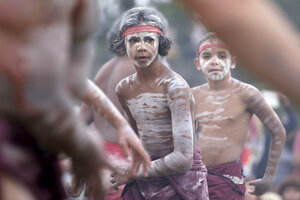Hair apparent: Study links modern Australian Aboriginals with the continent's earliest settlers
Aboriginals settled Australia 50,000 years ago, establishing geographic patterns that persist to this day, report scientists citing hair samples as evidence.

Young members of the Aboriginal community take part in a traditional ceremony as part of Australia Day celebration in Sydney, Australia, on Jan. 26, 2017. The Aboriginal people perform their ancient custom during Australia Day.
Rick Rycroft
Rick Rycroft/AP
While rivers watered Saharan greenery and Neanderthals hunted hapless Eurasian mammoths, the Aboriginal ancestors were already setting down roots across Australia 50,000 years ago.
According to the results of an extensive DNA hair sample analysis, the Aborigines spread out over the continent swiftly, settling into geographically distinct populations that persist today. The study, which was carried out by the Aboriginal Heritage Project and published Thursday in Nature, reaffirms the deep ties between the Aboriginal people and the Australian country.
"This is unlike people anywhere else in the world and provides compelling support for the remarkable Aboriginal cultural connection to country," said project leader Alan Cooper in a press release. "We're hoping this project leads to a rewriting of Australia's history texts to include detailed Aboriginal history and what it means to have been on their land for 50,000 years – that's around 10 times as long as all of the European history we're commonly taught."
Researchers compared DNA from more than a hundred hair samples shared by the South Australian Museum’s collection. The samples were gathered from Aboriginal people as part of a series of anthropological expeditions across Australia from the 1930s to 1960s.
Human cells carry DNA in two places: the cell's nucleus and the organelle mitochondrion. Some nuclear DNA is inherited from each parent, but it is unpredictable which parent's genes will get passed on each generation. But mitochondrial DNA always contains a perfect copy of the mother’s genetic information. Mitochondrial DNA is passed on from mother to child unchanged, except for the occasional random mutation. Knowing how often these changes tend to take place, scientists can measure how closely two people are related by comparing their mitochondrial genomes.
This analysis of modern day Aboriginal genetics allowed researchers to reconstruct a historical map of ancient migration. They learned that the Aboriginal ancestors arrived from the then-connected Papua New Guinea, then split, carrying out what the scientists described as "a single, rapid migration along the east and west coasts that reached southern Australia" somewhere between 45,000 to 49,000 years ago.
But "the amazing bit," as Dr. Cooper, director of Australian Centre for Ancient DNA at the University of Adelaide, puts it in an explanatory video, "is that they don’t seem to move again once they’ve done that. There’re small movements into the desert interior, but that basic pattern has held for 50,000 years." Longer, he added, than any other people anywhere else in the world.
In other words, the location of many modern communities can be traced back essentially to the beginning of human prehistory, despite "substantial climatic and cultural change during the late Pleistocene and Holocene epochs."
The discovery comes as no surprise to the Aborigines themselves. "Aboriginal people have always known that we have been on our land since the start of our time," Kaurna elder Lewis O'Brien, one of the original hair donors and an adviser for the study, said in the press release. "But it is important to have science show that to the rest of the world. This is an exciting project and we hope it will help assist those of our people from the Stolen Generation and others to reunite with their families."
Scientific investigations have met with resistance from native peoples before, such as the struggle over the 9,000-year-old Kennewick man in North America, but the Aboriginal Heritage Project worked closely with the University of Adelaide to consult with and gain permission from the involved Aboriginal families and the community at large.
"We are very grateful for the enthusiasm and overwhelming support for this project we have received from Aboriginal families, and the Cherbourg, Koonibba, and Point Pearce communities in particular," said Cooper.
The current investigation is just the beginning of a decade-long project that will study Aboriginal heritage and ancestry, and map out the genealogical history of families.

